sensor Citroen DS5 2014 1.G Owner's Manual
[x] Cancel search | Manufacturer: CITROEN, Model Year: 2014, Model line: DS5, Model: Citroen DS5 2014 1.GPages: 372, PDF Size: 32.58 MB
Page 5 of 372
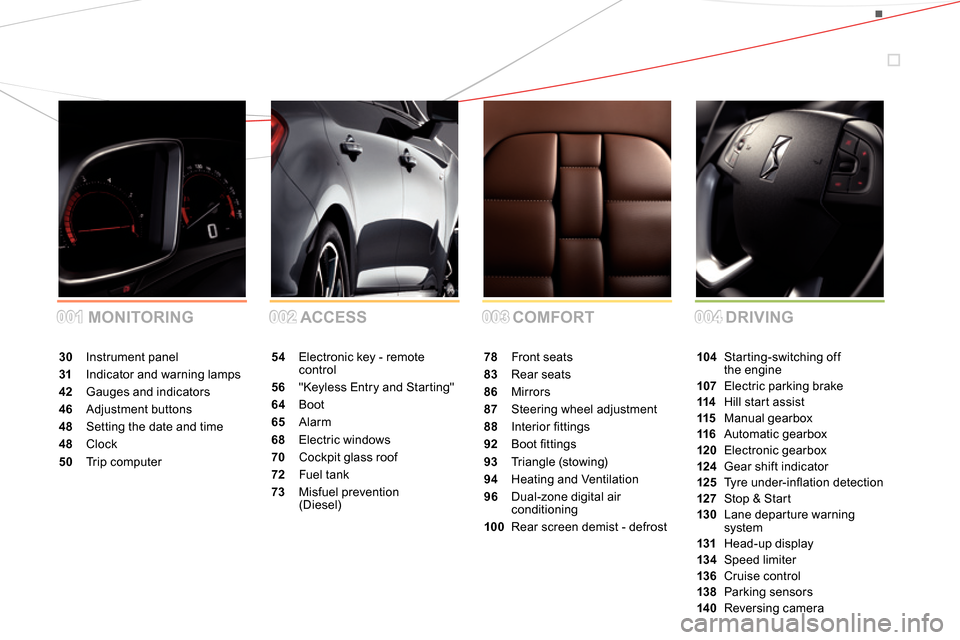
001001002002003003004004 COMFORT ACCESS MONITORINGDRIVING
30 Instrument panel
31 Indicator and warning lamps
42 Gauges and indicators
46 Adjustment buttons
48 Setting the date and time
48 Clock
50 Tr i p c o m p u t e r54 Electronic key - remote
control
56 "Keyless Entry and Starting"
64 Boot
65 Alarm
68 Electric windows
70 Cockpit glass roof
72 Fuel tank
73 Misfuel prevention
(Diesel)78 Front seats
83 Rear seats
86 Mirrors
87 Steering wheel adjustment
88 Interior fi ttings
92 Boot fi ttings
93 Triangle (stowing)
94 Heating and Ventilation
96 Dual-zone digital air
conditioning
100 Rear screen demist - defrost104 Starting-switching off
the engine
107 Electric parking brake
114 Hill start assist
115 Manual gearbox
116 Automatic gearbox
120 Electronic gearbox
124 Gear shift indicator
125 Ty r e u n d e r- i nfl ation detection
127 Stop & Start
130 Lane departure warning
system
131 Head-up display
13 4 Speed limiter
136 Cruise control
138 Parking sensors
14 0 Reversing camera
Page 11 of 372
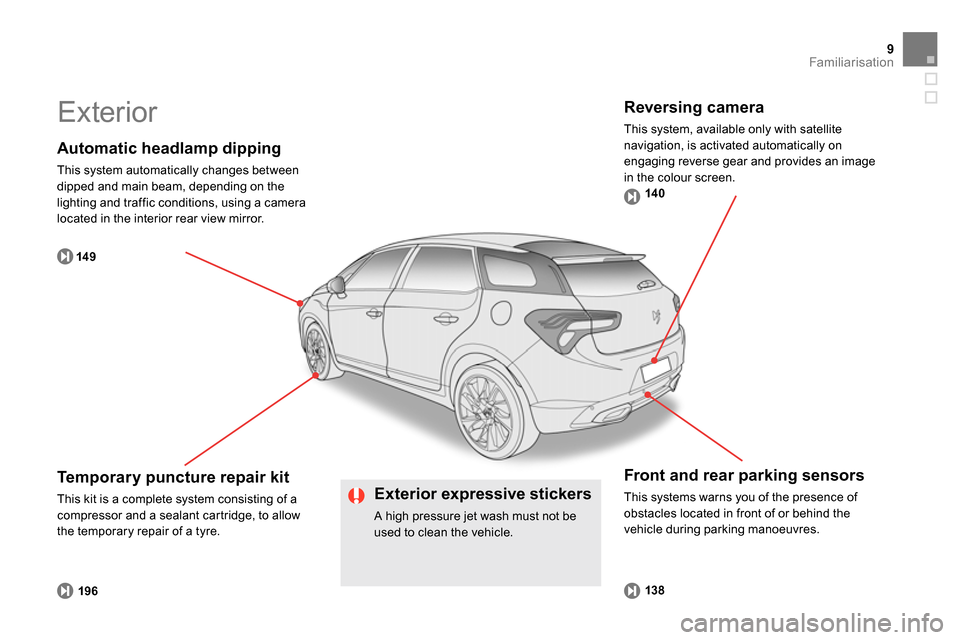
14 9
138
19614 0
9Familiarisation
Automatic headlamp dipping
This system automatically changes between
dipped and main beam, depending on the
lighting and traffic conditions, using a camera
located in the interior rear view mirror.
Front and rear parking sensors
This systems warns you of the presence of
obstacles located in front of or behind the
vehicle during parking manoeuvres.
Temporary puncture repair kit
This kit is a complete system consisting of a
compressor and a sealant cartridge, to allow
the temporary repair of a tyre.
Exterior
Reversing camera
This system, available only with satellite
navigation, is activated automatically on
engaging reverse gear and provides an image
in the colour screen.
Exterior expressive stickers
A high pressure jet wash must not be
used to clean the vehicle.
Page 14 of 372
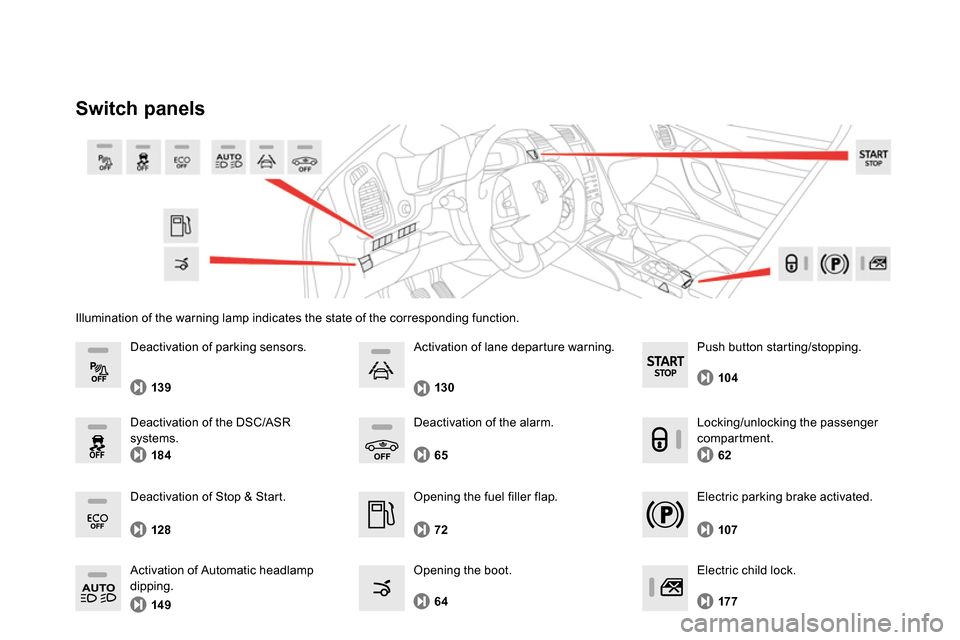
72 65
64107 104
128 139
17 7 184
14 9130
62 Illumination of the warning lamp indicates the state of the corresponding function.
Switch panels
Opening the fuel filler flap.
Opening the boot.
Deactivation of the alarm.
Electric parking brake activated.
Push button starting/stopping.
Deactivation of Stop & Start.
Deactivation of parking sensors.
Electric child lock.
Deactivation of the DSC/ASR
systems.
Activation of Automatic headlamp
dipping.
Activation of lane departure warning.
Locking/unlocking the passenger
compartment.
Page 42 of 372
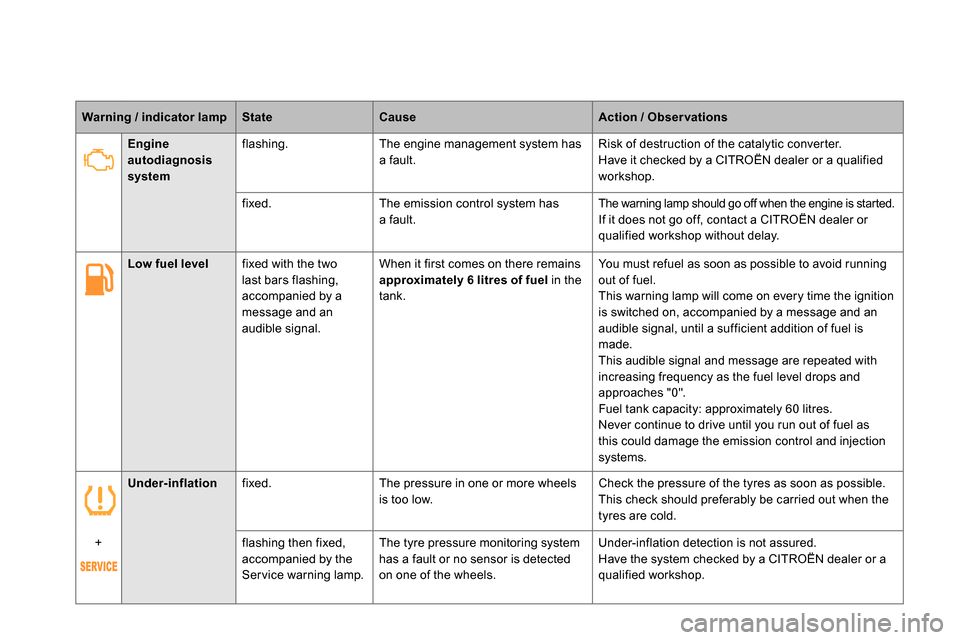
Under-inflation
fixed. The pressure in one or more wheels
is too low. Check the pressure of the tyres as soon as possible.
This check should preferably be carried out when the
tyres are cold.
+
flashing then fixed,
accompanied by the
Ser vice warning lamp. The tyre pressure monitoring system
has a fault or no sensor is detected
on one of the wheels. Under-inflation detection is not assured.
Have the system checked by a CITROËN dealer or a
qualified workshop.
Warning / indicator lamp
State
Cause
Action / Observations
Engine
autodiagnosis
system
flashing. The engine management system has
a fault. Risk of destruction of the catalytic converter.
Have it checked by a CITROËN dealer or a qualified
workshop.
fixed. The emission control system has
a fault.
The warning lamp should go off when the engine is started.
If it does not go off, contact a CITROËN dealer or
qualified workshop without delay.
Low fuel level
fixed with the two
last bars flashing,
accompanied by a
message and an
audible signal. When it first comes on there remains
approximately 6 litres of
fuel
in the
tank. You must refuel as soon as possible to avoid running
out of fuel.
This warning lamp will come on every time the ignition
is switched on, accompanied by a message and an
audible signal, until a sufficient addition of fuel is
made.
This audible signal and message are repeated with
increasing frequency as the fuel level drops and
approaches "0".
Fuel tank capacity: approximately 60 litres.
Never continue to drive until you run out of fuel as
this could damage the emission control and injection
systems.
Page 89 of 372
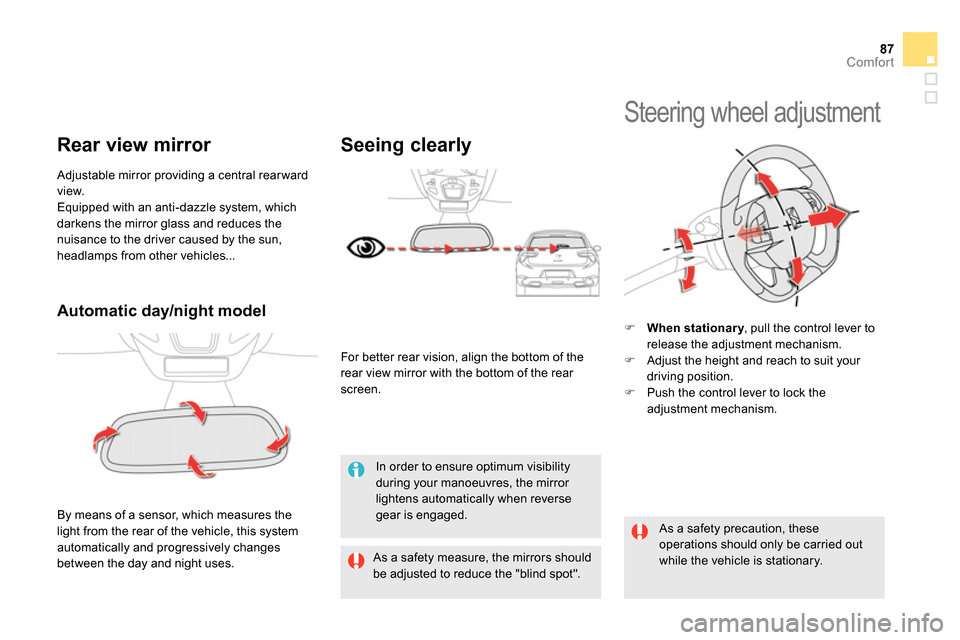
87Comfort
Automatic day/night model
By means of a sensor, which measures the
light from the rear of the vehicle, this system
automatically and progressively changes
between the day and night uses. Adjustable mirror providing a central rear ward
view.
Equipped with an anti-dazzle system, which
darkens the mirror glass and reduces the
nuisance to the driver caused by the sun,
headlamps from other vehicles...
Rear view mirror
In order to ensure optimum visibility
during your manoeuvres, the mirror
lightens automatically when reverse
gear is engaged.
Steering wheel adjustment
When stationary
, pull the control lever to
release the adjustment mechanism.
Adjust the height and reach to suit your
driving position.
Push the control lever to lock the
adjustment mechanism.
As a safety precaution, these
operations should only be carried out
while the vehicle is stationary.
As a safety measure, the mirrors should
be adjusted to reduce the "blind spot".
Seeing clearly
For better rear vision, align the bottom of the
rear view mirror with the bottom of the rear
screen.
Page 97 of 372

95Comfort
In order for these systems to be fully effective, follow the operation and maintenance
guidelines below:
To obtain an even air distribution, take care not to obstruct the exterior air intake grilles
located at the base of the windscreen, the nozzles, the vents and the air outlets, as well
as the air extractor located in the boot.
Do not cover the sunshine sensor, located on the dashboard; this is used for regulation
of the digital air conditioning system.
Operate the air conditioning system for at least 5 to 10 minutes, once or twice a month
to keep it in per fect working order.
Ensure that the passenger compartment filter is in good condition and have the filter
elements replaced regularly (refer to the "Checks" section).
We recommend the use of a combined passenger compartment filter. Thanks to its
special active additive, it contributes to the purification of the air breathed by the
occupants and the cleanliness of the passenger compartment (reduction of allergic
symptoms, bad odours and greasy deposits).
To ensure correct operation of the air conditioning system, you are also advised to have
it checked regularly as recommended in the maintenance and warranty guide.
If the system does not produce cold air, switch it off and contact a CITROËN dealer or a
qualified workshop.
You can switch off the air conditioning (AC button) and stay in Automatic mode in order
to limit fuel consumption. If misting appears while in this mode, you can switch the air
conditioning back on temporarily to improve the situation.
When towing the maximum load on a steep gradient in high temperatures, switching off the
air conditioning increases the available engine power and so improves the towing ability.
Recommendations for ventilation and air conditioning
If after an extended stop in sunshine,
the interior temperature is very high, first
ventilate the passenger compartment for
a few moments.
Put the air flow control at a setting high
enough to quickly change the air in the
passenger compartment.
The air conditioning system does not
contain chlorine and does not present
any danger to the ozone layer.
The condensation created by the air
conditioning results in a discharge
of water under the vehicle which is
per fectly normal.
If you want to prioritise heating, start
and leave the engine running by
pressing ECO OFF.
Page 100 of 372

5. Air conditioning On / Off
Press this button to switch off
the air conditioning.
Switching the system off could result in
discomfort (humidity, condensation).
Press this button again to return to
automatic operation of the air conditioning.
The indicator lamp in the "A /C "
button
comes on.
To obtain cool air more quickly, you can
use recirculation of the interior air for a
few moments. Then revert to the intake of
exterior air.
6. Air distribution adjustment
Press one or more buttons to
direct the air flow towards:
- the windscreen and side windows,
- the outer and centre air vents,
- the footwells.
You can combine the three orientations to
obtain the desired air distribution.
7. Air fl ow adjustment
Turn this control to the left to
decrease the air flow or to the
right to increase the air flow.
The air flow indicator lamps, between the two
fans, come on progressively in relation to the
value requested.
8. Air intake / Air recirculation
Air recirculation enables the passenger
compartment to be isolated from exterior odours
and smoke when external pollution is detected
(if your vehicle is fitted with a pollution sensor).
It is activated automatically on operation of the
screenwash.
It is inactive when the ambient temperature is
below 5 °C to avoid the risk of misting in the
vehicle.
- The indicator lamp with "A" on
indicates that recirculation is
controlled automatically.
- The indicator lamp without "A"
on indicates that recirculation
is forced manually.
- Both indicator lamps off
indicates that recirculation is
controlled automatically without
taking account of the detection
of pollution.
Without pollution sensor
If your vehicle is not fitted with a
pollution sensor, press this button
to force recirculation manually.
Page 127 of 372
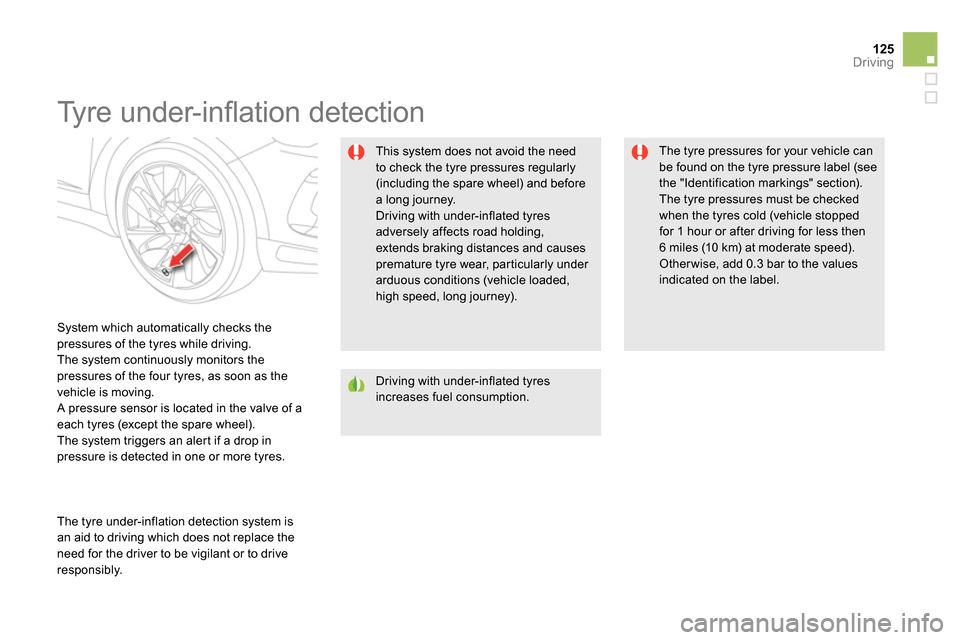
125Driving
Ty r e u n d e r - i nfl ation detection
System which automatically checks the
pressures of the tyres while driving.
The system continuously monitors the
pressures of the four tyres, as soon as the
vehicle is moving.
A pressure sensor is located in the valve of a
each tyres (except the spare wheel).
The system triggers an alert if a drop in
pressure is detected in one or more tyres.
This system does not avoid the need
to check the tyre pressures regularly
(including the spare wheel) and before
a long journey.
Driving with under-inflated tyres
adversely affects road holding,
extends braking distances and causes
premature tyre wear, particularly under
arduous conditions (vehicle loaded,
high speed, long journey).
Driving with under-inflated tyres
increases fuel consumption.
The tyre pressures for your vehicle can
be found on the tyre pressure label (see
the "Identification markings" section).
The tyre pressures must be checked
when the tyres cold (vehicle stopped
for 1 hour or after driving for less then
6 miles (10 km) at moderate speed).
Other wise, add 0.3 bar to the values
indicated on the label.
The tyre under-inflation detection system is
an aid to driving which does not replace the
need for the driver to be vigilant or to drive
responsibly.
Page 128 of 372
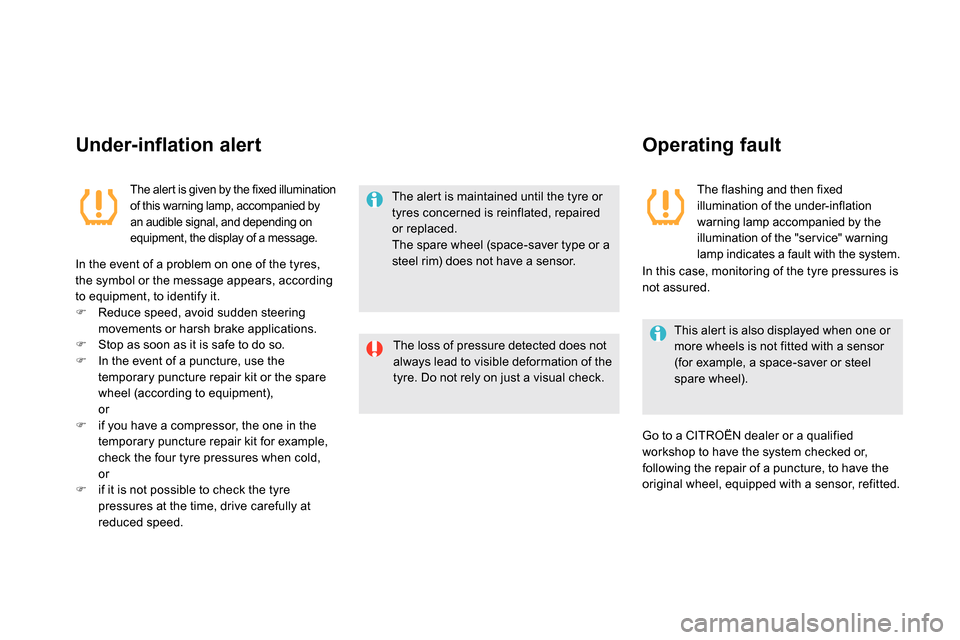
Under-inflation alert
The aler t is given by the fixed illumination
of this warning lamp, accompanied by
an audible signal, and depending on
equipment, the display of a message.
In the event of a problem on one of the tyres,
the symbol or the message appears, according
to equipment, to identify it.
Reduce speed, avoid sudden steering
movements or harsh brake applications.
Stop as soon as it is safe to do so.
In the event of a puncture, use the
temporary puncture repair kit or the spare
wheel (according to equipment),
or
if you have a compressor, the one in the
temporary puncture repair kit for example,
check the four tyre pressures when cold,
or
if it is not possible to check the tyre
pressures at the time, drive carefully at
reduced speed.
The alert is maintained until the tyre or
tyres concerned is reinflated, repaired
or replaced.
The spare wheel (space-saver type or a
steel rim) does not have a sensor.
The loss of pressure detected does not
always lead to visible deformation of the
tyre. Do not rely on just a visual check.
Operating fault
The flashing and then fixed
illumination of the under-inflation
warning lamp accompanied by the
illumination of the "ser vice" warning
lamp indicates a fault with the system.
This alert is also displayed when one or
more wheels is not fitted with a sensor
(for example, a space-saver or steel
spare wheel).
Go to a CITROËN dealer or a qualified
workshop to have the system checked or,
following the repair of a puncture, to have the
original wheel, equipped with a sensor, refitted.
In this case, monitoring of the tyre pressures is
not assured.
Page 140 of 372
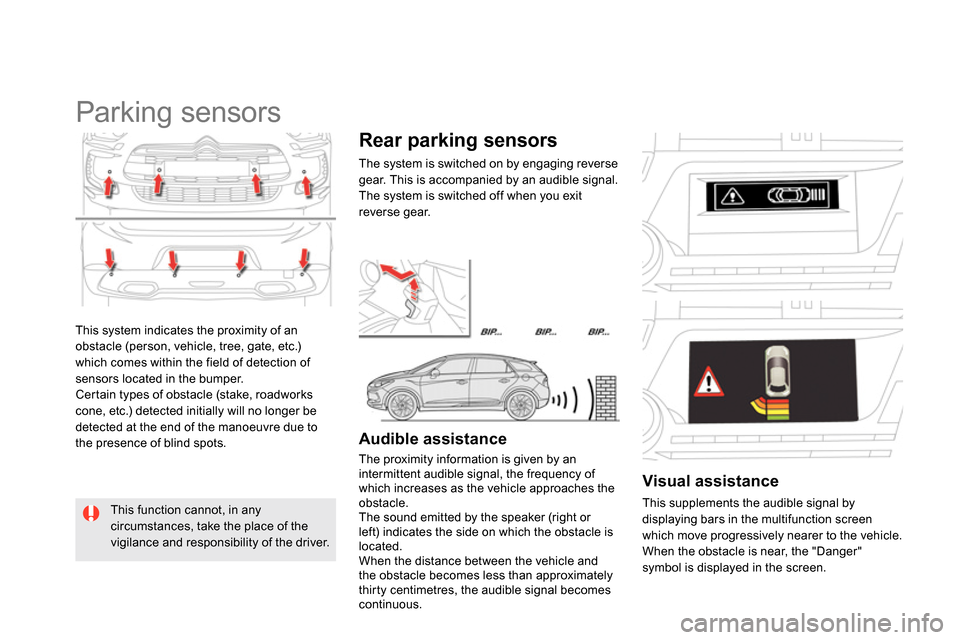
This system indicates the proximity of an
obstacle (person, vehicle, tree, gate, etc.)
which comes within the field of detection of
sensors located in the bumper.
Certain types of obstacle (stake, roadworks
cone, etc.) detected initially will no longer be
detected at the end of the manoeuvre due to
the presence of blind spots.
Parking sensors
This function cannot, in any
circumstances, take the place of the
vigilance and responsibility of the driver.
Rear parking sensors
The system is switched on by engaging reverse
gear. This is accompanied by an audible signal.
The system is switched off when you exit
reverse gear.
Audible assistance
The proximity information is given by an
intermittent audible signal, the frequency of
which increases as the vehicle approaches the
obstacle.
The sound emitted by the speaker (right or
left) indicates the side on which the obstacle is
located.
When the distance between the vehicle and
the obstacle becomes less than approximately
thirty centimetres, the audible signal becomes
continuous.
Visual assistance
This supplements the audible signal by
displaying bars in the multifunction screen
which move progressively nearer to the vehicle.
When the obstacle is near, the "Danger"
symbol is displayed in the screen.